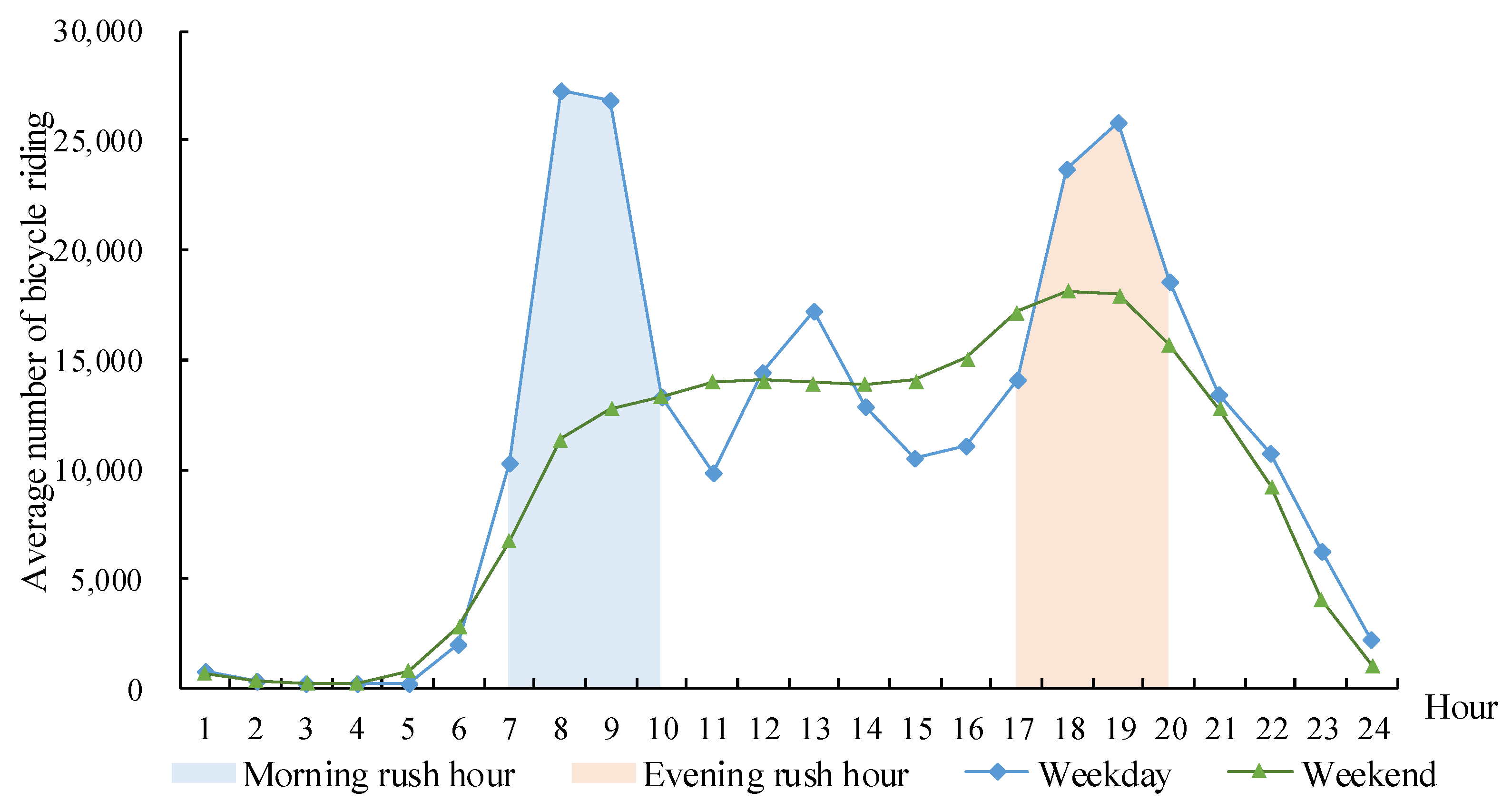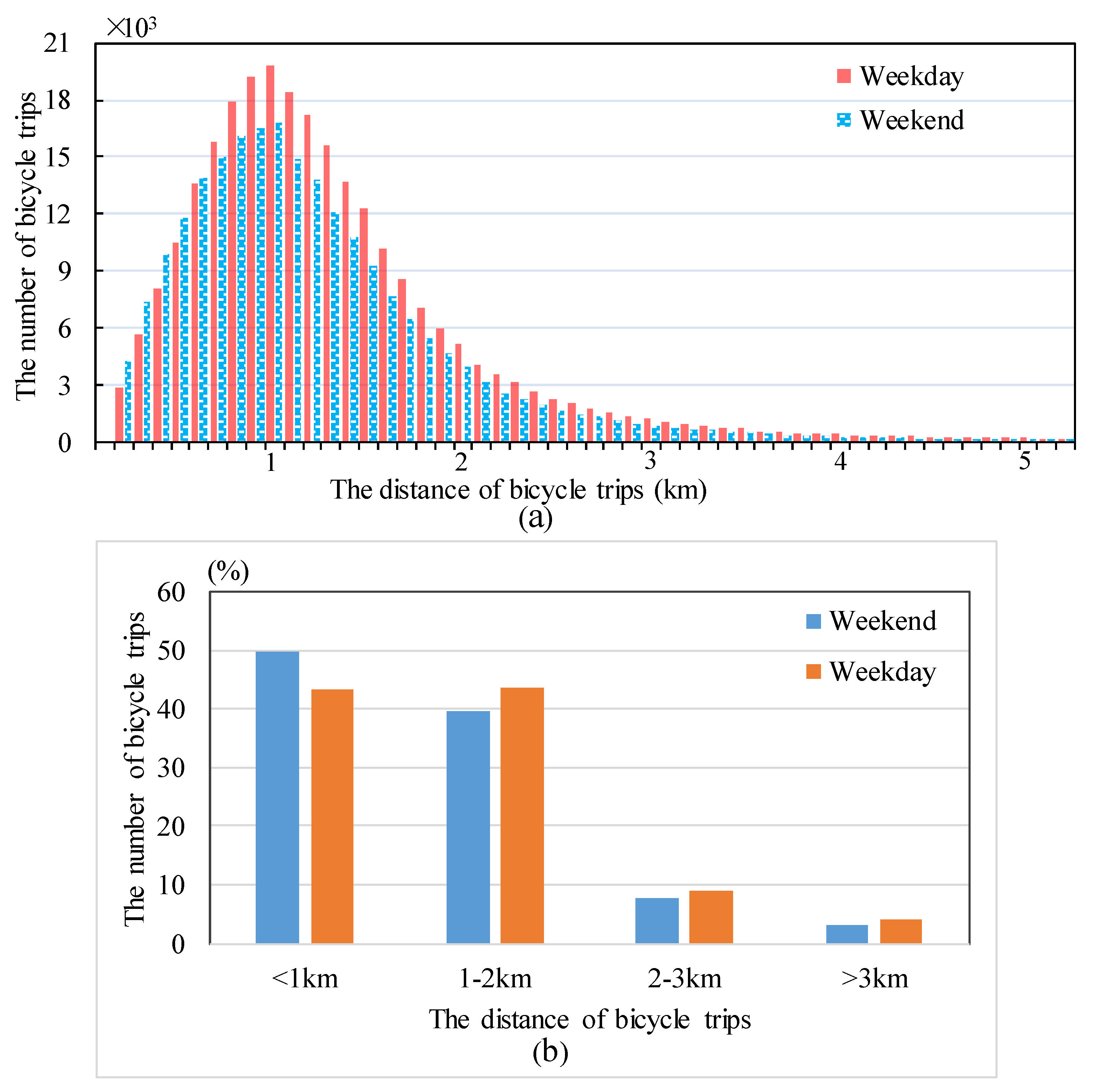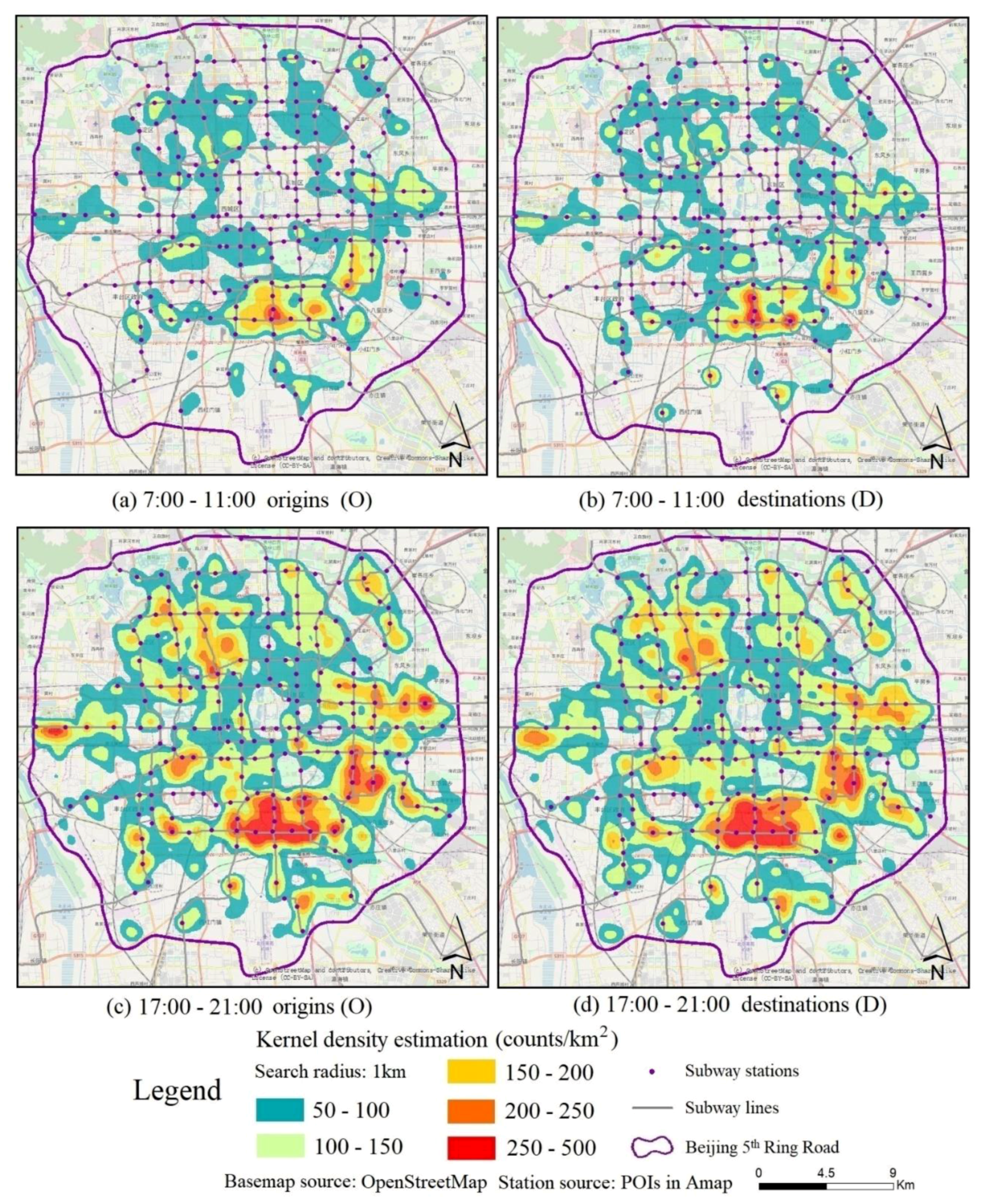Effects of Free-Floating Shared Bicycles on Urban Public Transportation
Abstract
:1. Introduction
2. Case Study and Spatial-Temporal Analysis
2.1. Study Area and Data Processing
2.2. Spatial-Temporal Characteristics of Shared Bicycle Trips
2.2.1. Time Series Analysis and Statistics of Riding Distance
2.2.2. Hotspot Analysis
3. Effects of Shared Bicycles on Urban Public Transportation
3.1. OD Points Associated with the Subway and Bus Stations
3.2. Sink-Source Characteristics of Shared Bicycles
3.3. Expanding the Subway and Bus Station Service Areas
4. Conclusions
Author Contributions
Funding
Acknowledgments
Conflicts of Interest
References
- Shaheen, S.A.; Guzman, S.; Zhang, H. Bikesharing in Europe, the Americas, and Asia: Past, present, and future. Transp. Res. Record. 2010, 2143, 159–167. [Google Scholar] [CrossRef]
- Vogel, P.; Greiser, T.; Mattfeld, D.C. Understanding bike-sharing systems using data mining: Exploring activity patterns. Procedia Soc. Behav. Sci. 2011, 20, 514–523. [Google Scholar] [CrossRef]
- Pal, A.; Zhang, Y. Free-floating bike sharing: Solving real-life large-scale static rebalancing problems. Transp. Res. Pt. C Emerg. Technol. 2017, 80, 92–116. [Google Scholar] [CrossRef]
- Du, M.; Cheng, L. Better understanding the characteristics and influential factors of different travel patterns in free-floating bike sharing: Evidence from Nanjing, China. Sustainability 2018, 10, 1244. [Google Scholar] [CrossRef]
- Xin, F.; Chen, Y.; Wang, X.; Chen, X. Cyclist satisfaction evaluation model for free-floating bike-sharing system: A case study of Shanghai. Transp. Res. Record. 2018, 2672, 21–32. [Google Scholar] [CrossRef]
- Ma, Y.; Lan, J.; Thornton, T.; Mangalagiu, D.; Zhu, D. Challenges of collaborative governance in the sharing economy: The case of free-floating bike sharing in Shanghai. J. Clean Prod. 2018, 197, 356–365. [Google Scholar] [CrossRef]
- O’ brien, O.; Cheshire, J.; Batty, M. Mining bicycle sharing data for generating insights into sustainable transport systems. J. Transp. Geogr. 2014, 34, 262–273. [Google Scholar] [CrossRef]
- Munoz-Mendez, F.; Klemmer, K.; Han, K.; Jarvis, S. Community structures, interactions and dynamics in London’s bicycle sharing network. In Proceedings of the 7th International Workshop on Pervasive Urban Applications, New York, NY, USA, 8–12 October 2018. [Google Scholar]
- Boss, D.; Nelson, T.; Winters, M.; Ferster, C.J. Using crowdsourced data to monitor change in spatial patterns of bicycle ridership. J. Transp. Health. 2018, 9, 226–233. [Google Scholar] [CrossRef]
- Come, E.; Randriamanamihaga, N.A.; Oukhellou, L.; Aknin, P. Spatio-temporal analysis of dynamic origin-destination data using latent dirichlet allocation: Application to Vélib’ Bike sharing system of Paris. In Proceedings of the TRB 93rd Annual meeting, Washington, DC, USA, 12–16 January 2014. [Google Scholar]
- Faghih-Imani, A.; Eluru, N. Incorporating the impact of spatio-temporal interactions on bicycle sharing system demand: A case study of New York CitiBike system. J. Transp. Geogr. 2016, 54, 218–227. [Google Scholar] [CrossRef]
- Borgnat, P.; Abry, P.; Flandrin, P.; Rouquier, J.B. Studying Lyon’s Vélo’V: A statistical cyclic model. In Proceedings of the European Conference on Complex Systems, Coventry, UK, 21–25 September 2009. [Google Scholar]
- Froehlich, J.E.; Neumann, J.; Oliver, N. Sensing and predicting the pulse of the city through shared bicycling. In Proceedings of the 21st International Joint Conference on Artificial Intelligence, Pasadena, CA, USA, 11–17 July 2009. [Google Scholar]
- Zhang, X.; Li, W.; Zhang, F.; Liu, R.; Du, Z. Identifying Urban Functional Zones Using Public Bicycle Rental Records and Point-of-Interest Data. ISPRS Int. Geo Inf. 2018, 7, 459. [Google Scholar] [CrossRef]
- Zhang, Y.; Brussel, M.J.; Thomas, T.; van Maarseveen, M.F. Mining bike-sharing travel behavior data: An investigation into trip chains and transition activities. Comput. Environ. Urban Syst. 2018, 69, 39–50. [Google Scholar] [CrossRef]
- Caggiani, L.; Ottomanelli, M.; Camporeale, R.; Binetti, M. Spatio-temporal clustering and forecasting method for free-floating bike sharing systems. In Proceedings of the International Conference on Systems Science, Wrocław, Poland, 7–9 September 2016. [Google Scholar]
- Shi, X.; Yu, Z.; Fang, Q.; Zhou, Q. A Visual Analysis Approach for Inferring Personal Job and Housing Locations Based on Public Bicycle Data. ISPRS Int. Geo Inf. 2017, 6, 205. [Google Scholar] [CrossRef]
- Deng, L.; Xie, Y.; Huang, D. Bicycle-sharing facility planning base on riding spatio-temporal data. Planners. 2017, 33, 82–88. [Google Scholar]
- Gao, Y.; Song, C.; Shu, H.; Pei, T. Spatial-temporal Characteristics of Source and Sink Points of Mobikes in Beijing and Its Scheduling Strategy. J. Geo Inf. Sci. 2018, 20, 1123–1138. [Google Scholar]
- Gu, Z.; Zhu, Y.; Zhang, Y.; Zhou, W.; Chen, Y. Heuristic Bike Optimization Algorithm to Improve Usage Efficiency of the Station-Free Bike Sharing System in Shenzhen, China. ISPRS Int. Geo Inf. 2019, 8, 239. [Google Scholar] [CrossRef]
- Labadi, K.; Benarbia, T.; Barbot, J.P.; Hamaci, S.; Omari, A. Stochastic petri net modeling, simulation and analysis of public bicycle sharing systems. IEEE Trans. Autom. Sci. Eng. 2015, 12, 1380–1395. [Google Scholar]
- Liu, Z.; Chen, Y. Analysis on distribution characteristics and influence factors of Mobike travel space in Changsha City. In Proceedings of the 2018 China Urban Planning Annual Meeting, Hangzhou, China, 23–26 November 2018. [Google Scholar]
- Zhang, J.; Pan, X.; Li, M.; Philip, S.Y. Bicycle-sharing system analysis and trip prediction. In Proceedings of the 2016 17th IEEE International Conference on Mobile Data Management (MDM), Porto, Portugal, 13–16 June 2016; pp. 174–179. [Google Scholar]
- Sun, L.; Wang, S.; Liu, S.; Yao, L.; Luo, W.; Shukla, A. A completive research on the feasibility and adaptation of shared transportation in mega-cities–A case study in Beijing. Appl. Energy. 2018, 230, 101–1033. [Google Scholar] [CrossRef]
- Cerutti, P.S.; Martins, R.D.; Macke, J.; Sarate, J.A.R. Green, but not as green as that: An analysis of a Brazilian bike-sharing system. J. Clean. Prod. 2019, 217, 185–193. [Google Scholar] [CrossRef]
- Lin, F.; Jiang, J.; Fan, J.; Wang, S. A stacking model for variation prediction of public bicycle traffic flow. Intell. Data Anal. 2018, 22, 911–933. [Google Scholar] [CrossRef]
- Yang, X.H.; Cheng, Z.; Chen, G.; Wang, L.; Ruan, Z.Y.; Zheng, Y.J. The impact of a public bicycle-sharing system on urban public transport networks. Transp. Res. Pt. A-Policy Prac. 2018, 107, 246–256. [Google Scholar] [CrossRef]
- Jäppinen, S.; Toivonen, T.; Salonen, M. Modelling the potential effect of shared bicycles on public transport travel times in Greater Helsinki: An open data approach. Appl. Geogr. 2013, 43, 13–24. [Google Scholar] [CrossRef]
- Li, W.; Tian, L.; Gao, X.; Batool, H. Effects of dockless bike-sharing system on public bike system: Case study in Nanjing, China. Energy Procedia. 2019, 158, 3754–3759. [Google Scholar] [CrossRef]
- Anderson, T.K. Kernel density estimation and K-means clustering to profile road accident hotspots. Accid. Anal. Prev. 2009, 41, 359–364. [Google Scholar] [CrossRef] [PubMed]
- Heidenreich, N.B.; Schindler, A.; Sperlich, S. Bandwidth selection for kernel density estimation: A review of fully automatic selectors. AStA Adv. Stat. Anal. 2013, 97, 403–433. [Google Scholar] [CrossRef]
- Kang, Y.; Cho, N.; Son, S. Spatiotemporal characteristics of elderly population’s traffic accidents in Seoul using space-time cube and space-time kernel density estimation. PLoS ONE 2018, 13, e0196845. [Google Scholar] [CrossRef] [PubMed]
- Wang, Y.; Feng, C.; Liu, Y.; Zhao, Y.; Li, H.; Zhao, T.; Guo, W. Comparative study of species sensitivity distributions based on non-parametric kernel density estimation for some transition metals. Environ. Pollut. 2017, 221, 343–350. [Google Scholar] [CrossRef]
- Xie, Z.; Yan, J. Kernel density estimation of traffic accidents in a network space. Comput. Environ. Urban Syst. 2008, 32, 396–406. [Google Scholar] [CrossRef]
- Lin, H.; Chen, M.; Lu, G.N.; Zhu, Q.; Gong, J.H.; You, X.; Wen, Y.N.; Xu, B.L.; Hu, M.Y. Virtual Geographic Environments (VGEs): A New Generation of Geographic Analysis Tool. Earth Sci. Rev. 2013, 112, 74–84. [Google Scholar] [CrossRef]
- Lin, H.; Chen, M.; Lu, G.N. Virtual Geographic Environment: A Workspace for Computer-Aided Geographic Experiments. Ann. Am. Assoc. Geogr. 2013, 103, 456–482. [Google Scholar] [CrossRef]
- Wen, Y.N.; Chen, M.; Lu, G.N.; Lin, H. Prototyping an open environment for sharing geographical analysis models on cloud computing platform. Int. J. Digit. Earth. 2013, 6, 356–382. [Google Scholar] [CrossRef]
- Chen, M.; Yue, S.S.; Lu, G.N.; Lin, H.; Yang, C.W.; Wen, Y.N.; Tao, H.; Xiao, D.W.; Jiang, H. Teamwork-oriented integrated modeling method for geo-problem solving. Environ. Model. Softw. 2019, 119, 111–123. [Google Scholar] [CrossRef]
- Zhang, F.Y.; Chen, M.; Ames, D.P.; Shen, C.R.; Yue, S.S.; Wen, Y.N.; Lu, G.N. Design and Development of a Service-oriented Wrapper System for Sharing and Reusing Distributed Geoanalysis Models on the Web. Environ. Model. Softw. 2019, 111, 498–509. [Google Scholar] [CrossRef]
- Wang, J.; Chen, M.; Lu, G.N.; Yue, S.S.; Chen, K.; Wen, Y.N. A Study on Data Processing Services for the Operation of Geo-Analysis Models in the Open Web Environment. Earth Space Sci. 2018, 5, 844–862. [Google Scholar] [CrossRef]
- Park, C.; Sohn, S.Y. An optimization approach for the placement of bicycle-sharing stations to reduce short car trips: An application to the city of Seoul. Transp. Res. Pt. A Policy Pract. 2017, 105, 154–166. [Google Scholar] [CrossRef]
- Cressie, N.A.C.; Whitford, H.J. How to use the two sample t-test. Biometrical. J. 1986, 28, 131–148. [Google Scholar] [CrossRef]
- Gavriilaki, E.; Yuan, X.; Ye, Z.; Ambinder, A.J.; Shanbhag, S.P.; Streiff, M.B.; Kickler, T.S.; Moliterno, A.R.; Sperati, C.J.; Brodsky, R.A. Modified ham test for atypical hemolytic uremic syndrome. Blood 2015, 125, 3637–3646. [Google Scholar] [CrossRef]
- Weliwitiya, H.; Rose, G.; Johnson, M. Bicycle train intermodality: Effects of demography, station characteristics and the built environment. J. Transp. Geogr. 2019, 74, 395–404. [Google Scholar] [CrossRef]










| Number of OD Points around/not around the Stations | Mean | p-Value | |
|---|---|---|---|
| Subway stations | around (within the range of 1.5 km) | 1424.92 | |
| not around (outside the range of 1.5 km) | 281.30 | ||
| Bus stations | around (within the range of 500 m) | 140.16 | 0 |
| not around (outside the range of 500m) | 0.77 | ||
| Type of Station | Classification Basis | Typical Area Around the Subway and Bus Stations |
|---|---|---|
| Type of source | and | Residential area, more services for daily life. |
| Type of sink | and | Companies, offices and institutions, more services for daily affairs. |
| Source in the morning and sink in the evening | and | Companies and universities, more services for commuting. |
| Sink in the morning and source in the evening | and | Residential area and student apartments, more services for commuting. |
| Type of equalization | and | Balanced distribution of companies, residential area, shopping malls, leisure and entertainment areas, and other buildings. |
© 2019 by the authors. Licensee MDPI, Basel, Switzerland. This article is an open access article distributed under the terms and conditions of the Creative Commons Attribution (CC BY) license (http://creativecommons.org/licenses/by/4.0/).
Share and Cite
Cao, M.; Ma, S.; Huang, M.; Lü, G.; Chen, M. Effects of Free-Floating Shared Bicycles on Urban Public Transportation. ISPRS Int. J. Geo-Inf. 2019, 8, 323. https://doi.org/10.3390/ijgi8080323
Cao M, Ma S, Huang M, Lü G, Chen M. Effects of Free-Floating Shared Bicycles on Urban Public Transportation. ISPRS International Journal of Geo-Information. 2019; 8(8):323. https://doi.org/10.3390/ijgi8080323
Chicago/Turabian StyleCao, Min, Shangjing Ma, Mengxue Huang, Guonian Lü, and Min Chen. 2019. "Effects of Free-Floating Shared Bicycles on Urban Public Transportation" ISPRS International Journal of Geo-Information 8, no. 8: 323. https://doi.org/10.3390/ijgi8080323
APA StyleCao, M., Ma, S., Huang, M., Lü, G., & Chen, M. (2019). Effects of Free-Floating Shared Bicycles on Urban Public Transportation. ISPRS International Journal of Geo-Information, 8(8), 323. https://doi.org/10.3390/ijgi8080323






